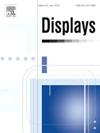视频观看过程中视觉疲劳的动态评估:基于任务后评级和视频特征的动态评级验证
IF 3.7
2区 工程技术
Q1 COMPUTER SCIENCE, HARDWARE & ARCHITECTURE
引用次数: 0
摘要
长时间观看视频显示屏的人会产生视觉疲劳和其他与视觉不适相关的症状。减少疲劳的技术经常被使用,但可能会降低身临其境的体验。为了适当调整疲劳消除技术,应分析视觉疲劳随时间的变化,这对适当调整疲劳消除技术至关重要。然而,用于评估视觉疲劳的传统方法并不完善,因为这些方法完全依赖于任务后调查,无法轻松确定动态变化。本研究采用了一种动态评估方法来实时评估视觉疲劳。参与者使用操纵杆,在感知到变化时持续评估主观疲劳度。模拟器晕机问卷(SSQ)验证了结果,结果表明动态评估与 SSQ 在与视觉不适症状相关的五个项目上存在显著相关性。此外,我们还探讨了动态视觉疲劳与客观视频特征之间的潜在关系,例如光流和色调/饱和度值(HSV)色彩空间的 V 值,它们代表了视频的运动和亮度。结果表明,动态视觉疲劳与光流和 V 值都有明显的相关性。此外,基于机器学习模型,我们确定视觉疲劳的变化可以根据光流和 V 值进行预测。总之,研究结果验证了动态评估方法可以为实时预测视觉疲劳提供可靠的基准。本文章由计算机程序翻译,如有差异,请以英文原文为准。
Dynamic assessment of visual fatigue during video watching: Validation of dynamic rating based on post-task ratings and video features
People watching video displays for long durations experience visual fatigue and other symptoms associated with visual discomfort. Fatigue-reduction techniques are often applied but may potentially degrade the immersive experience. To appropriately adjust fatigue-reduction techniques, the changes in visual fatigue over time should be analyzed which is crucial for the appropriate adjustment of fatigue-reduction techniques. However, conventional methods used for assessing visual fatigue are inadequate because they rely entirely on post-task surveys, which cannot easily determine dynamic changes. This study employed a dynamic assessment method for evaluating visual fatigue in real-time. Using a joystick, participants continuously evaluated subjective fatigue whenever they perceived changes. A Simulator Sickness Questionnaire (SSQ) validated the results, which indicated significant correlations between dynamic assessments and the SSQ across five items associated with symptoms associated with visual discomfort. Furthermore, we explored the potential relationship between dynamic visual fatigue and objective video features, e.g., optical flow and the V-values of the hue/saturation value (HSV) color space, which represent the motion and brightness of the video. The results revealed that dynamic visual fatigue significantly correlated with both the optical flow and the V-value. Moreover, based on machine learning models, we determined that the changes in visual fatigue can be predicted based on the optical flow and V-value. Overall, the results validate that dynamic assessment methods can form a reliable baseline for real-time prediction of visual fatigue.
求助全文
通过发布文献求助,成功后即可免费获取论文全文。
去求助
来源期刊

Displays
工程技术-工程:电子与电气
CiteScore
4.60
自引率
25.60%
发文量
138
审稿时长
92 days
期刊介绍:
Displays is the international journal covering the research and development of display technology, its effective presentation and perception of information, and applications and systems including display-human interface.
Technical papers on practical developments in Displays technology provide an effective channel to promote greater understanding and cross-fertilization across the diverse disciplines of the Displays community. Original research papers solving ergonomics issues at the display-human interface advance effective presentation of information. Tutorial papers covering fundamentals intended for display technologies and human factor engineers new to the field will also occasionally featured.
 求助内容:
求助内容: 应助结果提醒方式:
应助结果提醒方式:


